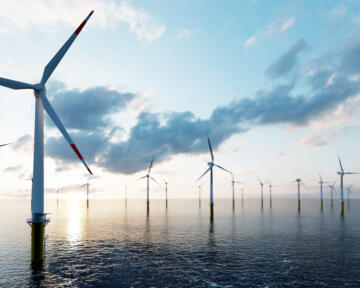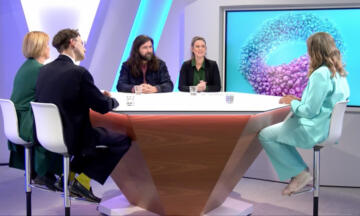On 15 April Kanaal Z gathered several experts around the table who each hold a key piece of the puzzle. Governments, civil society and the business world took part in a debate on how the private sector and government policy can mutually reinforce each other and become more sustainable.
Meanwhile circular entrepreneurship has become such a ubiquitous buzzword that most people are no longer aware of its many aspects. At the start of the debate, Brigitte Mouligneau of Circular Flanders and Valentin Vassart of Circular Wallonia dot the i’s and cross the t’s. They clarify: “Whereas linear production means you’re using new materials in your production process and discarding them as waste afterwards, circularityCircularity describes the quantity of materials managed in a closed loop. means manufacturing products with as few natural resources as possible - preferably recycled or recyclable materials - and with a maximum life cycle, and which can be recycled (again) to a high quality standard after use.”
Circularity in practice
That has set the tone of the conversation and our host Valérie Thys wanted to know how this works in practice. CEO Cédric Vanhoeck and CFO Christophe Berlo of textile recyclingAny recovery operation through which waste, including organic waste, is reprocessed to become substances, materials or products that can be used for their initial function or other functions. start-up Resortecs tell us all about the technology the company developed to make the recycling of clothing much more efficient. They indicate that “less than 1 % of all discarded clothing is recycled. We developed a technique consisting of two components. On the one hand there are the ‘smart stitch’ yarns that are compatible with any sowing machine but that are developed to melt when a clothing item is heated to a high temperature. On the other hand there are the thermal mechanical machines that disassemble large volumes of clothing through heating. The resulting high-quality fabrics can be reuseReuse designates all operations by which substances, materials or products that are not waste are used again in an identical way to their originally intended purpose.d.”
FPS Economy guides entrepreneurs
Why does circularity feature so high on everyone’s agenda all of a sudden? Lien Meurisse and Etienne Mignolet, spokespersons of the FPS Economy, regard the COVID-19 pandemic and climate change as key drivers. “Although awareness of the benefits of more sustainable production has been growing for some time, these crises have demonstrated how dependent we are on certain raw materials and energy sources. On a federal level we aim to guide entrepreneurs and familiarise them with the available options and the support that is available because they often lack the know-how to make the transition entirely on their own. We also explain the importance of using intellectual property to protect innovations or inventions. These are levers and guarantees of success that should benefit SMESmall and medium-sized enterprisess as much as possible. The FPS Economy centres all its info on circular entrepreneurship on the website Tijd voor Circulair where entrepreneurs can not only find tips and read inspiring testimonials but also find the available support measures and even a self-evaluation tool that assesses how circular their approach is and what can be improved.”
In addition to awareness there’s now a sense of urgency as well
Stéphane Vanden Broeck, adviser sustainable entrepreneurship at Unizo, and Thomas Lepers, adviser energy and circular entrepreneurship at UCM, confirm that for many companies, the crises of recent years have pushed the transition higher on their list of priorities. “It was a perfect storm. The awareness was already there, but now the statistics are also reflecting the urgency. For instance, a study by VITO showed that 66 % of businesses that implement a circular approach indicated they were hardly or not at all affected by the COVID crisis, whereas for linear companies that was just 2 %.” Of course, awareness as such doesn’t mean that taking steps towards circularity is easy. “We see that start-ups starting from scratch often do very well, for example because they opt for sustainable materials or renewable energyRenewable energy is energy derived from natural processes that are perpetually renewed, i.e. those of a solar, wind, hydraulic, geothermal or biomass origin. from day one. For established businesses this is usually much more difficult. Still, some of those companies are fully up to speed and simply need a sounding board to pitch their ideas.”
Setting the right example
The authorities are driving progress on a regional level as well. Brigitte Mouligneau of Circular Flanders and Valentin Vassart of Circular Wallonia emphasise the responsibility of governments. “We have examined our purchase policy and have switched to more circular suppliers and/or products. We want to lead by example in order to inspire private companies to follow suit.” But it certainly doesn’t stop there. “We are also placing maximum focus on consultation with the private sector through learning networks where colleagues engage in dialogue to identify which barriers can be reduced.”
Level European playing field
And then there’s also the European level. According to Cédric Vanhoeck and Christophe Berlo, these regulations have considerably accelerated the emergence of circularity. “If textile manufacturers or brands don’t switch to clothes on the basis of (partially) recycled fabrics in the next few years, they will find it hard to reach their markets as Europe is significantly tightening its regulations.” Fortunately this also comes with interesting subsidies. “We’ve had access to considerable resources for our innovation, both on a regional, federal and European level. However, businesses that progress from the development phase to actual rollout in the market have far fewer subsidy options. From then on they are forced to rely mostly on private capital.”
To be continued
The conclusion of the debate is clear: we are on the right track but there is plenty of room for improvement. A level European playing field, eliminating counterproductive rules, striking a good balance between knowledge sharing and protecting intellectual property and focusing on both ecological and economic sustainability are all topics that the panel members deem crucial. It’s a debate that will undoubtedly continue in various forms.
Watch the full debate (in Dutch).





